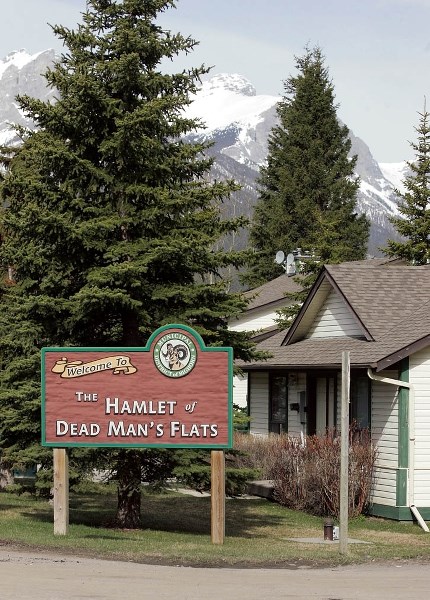A request to change the name of Dead Man’s Flats met no support from the MD of Bighorn administration or council, Tuesday (May 13).
Administration received a letter dated April 24 from a resident of Dead Man’s Flats requesting the MD consider changing the hamlet’s name to one that would be “in keeping with the beauty of the area,” according to the unidentified resident. While the letter was included in a council package as a public document, the name of the letter writer was redacted under the provisions of FOIP.
“Since purchasing our condo in 2006, I have wondered about the appropriateness of labelling a community with the undesirable name of ‘Dead Man’s Flats.’ Over the years, many people have asked us why we would choose to live in a place with an unpleasant name. Our response has been that, in spite of the name, the area offers unsur- passed natural beauty and outdoor opportunities,” the writer stated.
“Sadly, the gruesome name does not reflect the beautiful location of this community in the majestic mountains and Bow Valley. It also seems to me that the name could be a deterrent in terms of a tourism destination, business investment and attracting potential residents who may consider moving into the area in the future.”
Robert Ellis, Bighorn’s director of planning services, told council Tuesday (May 13) the hamlet’s name officially became known as Dead Man’s Flats in 1985.
“From 1974 to 1985, the hamlet was officially called Pigeon Mountain Service Centre, but the name was changed to Dead Man’s Flats in 1985 to encourage tourism. The area had been unofficially referred to as ‘Dead Man’s’ prior to the name change,” Ellis said, reading from his decision report.
Dead Man’s Flats is one of the few truly local and original names in the Bow Valley. Explorers to this region, such as James Hector, named many of the Bow Valley’s natural features. The Canadian Pacific Railway named Banff and Canmore. Exshaw was named for the main backer of the cement plant. Of course, all of the features and sites in the Bow Valley region had Aboriginal names before Europeans arrived.
In the early 1900s, the flats at the mouth of Wind Valley where Pigeon Creek enters the Bow River was home to a dairy farm owned by a man named Jean Marret. Jean also worked in the coalmines at Canmore.
Jean’s brother, François, arrived to work for him in 1904 and on May 12 at 5:30 a.m. Francois killed Jean with an axe blow to the head. François carried his brother’s corpse and dumped it in the Bow River.
“I put him in the river, as I thought his ghost would not come back to me,” he told a coroner’s jury. François also told the jury that he embodied the spirit of good, while his brother was the gift of evil, according to the May 14 edition of the Calgary Daily Herald.
François stated he killed Jean on the order of their dead parents because, despite his hard work at the dairy, Jean refused to pay him. François also believed that Jean was planning to kill him with a “whirring electrical machine” that Jean had built and hidden in the forest.
The North West Mounted Police arrested François in Canmore’s Oskaloosa Hotel after François reported to the mines why Jean would not be able to work that day.
At the inquiry, experts testified that François had been having auditory hallucinations, possibly a result of a brain disease he may have contracted while serving in Africa with the French Foreign Legion.
The jury at the coroner’s trial found François guilty of murder after a one-day trial. By May 19, at the end of a criminal trial, François was found not guilty of murder by reason of insanity.
François was committed to the Brandon Hospital in Manitoba, where he died years later.
But the tragic story of Jean – and of François Marret – is not the only “death” associated with the flats. According to a Stoney Nakoda version, a small group of Nakoda had been trapping beaver at the site, which until 1930 was part of Banff National Park.
When they noticed a national park warden headed their way, the trappers smeared beaver blood across their bodies and played dead. The warden found the blood-covered bodies and raced off to report the find to his superiors.
Once the warden had gone, the Nakoda trappers got to their feet, picked up the beaver and disappeared into the forest.
During his presentation on Tuesday (May 11), Ellis recommended discontinuing any further consideration to change the name.
Bighorn council agreed with Ellis, voting unanimously in favour of his recommendation.
To change the name of a hamlet would require a public process to select a new name. All provincial departments would have to be notified and addresses for all residents would change. The MD, meanwhile, would have to change all signs. It would take, according to Ellis, “considerable staff time, community time, financial resources and political capital to accommodate the name change.”




